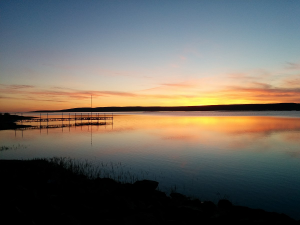9 test table
Tags: Culture, Literature, and Poetry, Adults, Intermediate
Activity Summary
After learning Òran nan Sealgairean, composed by Archie MacKenzie (Eirdsidh Sheumais) of Christmas Island, students will be able to look at the story within the song as a group. They will identify new or unusual vocabulary, discuss the purpose of the song, identify real places and mythological characters in the song, and finally create a storyboard to tell the story themselves.
Learning Outcomes
Students will:
- Develop the confidence and skill to tell a Gaelic story;
- Improve their vocabulary;
- Learn about a Nova Scotia Gaelic song, its creator, and his local community;
- Recognize a rhyme scheme in a Gaelic song;
- Learn about the Fenians, and discuss why they are referenced in “Song of the Hunters,” and how they represent aspects of the worldview of the Gaels;
- Use this song (and the story within it) to create a new story of their own describing a day out, an adventure, on a local scale, in a big way.
Gaelic Level
This activity can be used with advanced beginner or intermediate Gaelic learners. Beginners can also be included in the final storytelling session.
Lesson Preparation
Students will have learned the song well, prior to this lesson.
Resources
Required Resource:
- “The Songs of a Nation” by Frances MacEachan in Am Bràighe (p. 14)
- Sgeulachdan nan Gaisgeach | The Stories of Heroes by Ruairidh MacIlleathain
- History of Christmas Island Parish by Archibald MacKenzie
- Òran nan Sealgairean recording
- A flipchart or a wall-length whiteboard and plenty of coloured pens or markers or any other materials to illustrate a story.
Other Resources:
- Sgeulachdan nan Gaisgeach | Stories of Heroes from Seòras Mac a’ Phearsain and Ruairidh MacIlleathain
- “A Fenian Tale” translated in Am Bràighe (p. 24 and p. 27)
- Òran nan Sealgairean Gaelic lyrics (See Appendix for English translation)

Lesson Structure (1.5 hour class)
| Time | Activity | Resources |
| 20 min | Discuss the importance of song within Gaelic culture in Nova Scotia. Explain how comic songs would be sung less often, but gave great pleasure to local audiences who would recognize names and events. These songs — a little like an inside joke — were only ever fully understood in the small local community where they originated.
Put up the article “The Songs of a Nation” on the projector for students to read. |
MacEachen, F. “The Songs of a Nation,” (p. 14) |
| 20 min | Ask students if they have heard of the Fenians. Who are they? Together read and listen to a story about Oscar, one of the band of heroes. Discuss why the local hunters of our comic song are compared here to the Fenians. | MacIlleathain, R. “853: The Stories of Heroes.” |
| 10 min | Talk about the creator of the song — Archie MacKenzie — and the area where he lived, Rear Christmas Island in Cape Breton. | MacKenzie, Archibald J. History of Christmas Island Parish.
See p. 64 for a concise description of the author, and p. 145 for a fond entry concerning the early days in the parish: “Some of the Characteristics of the Pioneers of Christmas Island Parish” (St FX Digital Collections) |
| 20 min |
Listen together to an archive recording of the song more than once. Discuss unusual words such as euchdail. Make new sentences with it or use interesting sentences as templates to practice structure while following the rhythm, keeping the same number of syllables. For example,
Go around in a circle making up sentences without thinking too much over it, just keeping the rhythm. To make it easier, you could suggest each person substitutes just one word to change the sentence, and so on. Point out the complex Gaelic rhyme scheme within the verse:
|
MacKenzie, Archie. “Òran nan Sealgairean [Audio recording].” |
| 15 min | Separate into small groups or work as individuals to tell the story within the song. Give each group a verse or two to represent. Create simple or silly or dramatic illustrations from stick figures to more elaborate drawings, according to individual ability, to describe the action. Use the words from the song, and enhance them, with your own words, to develop the story further. Make the story your own. | |
| 5 min | Put the parts of the story together and perform it, if possible, for a group of learners. |
Variations
There are many ways to vary this activity.
1. Arrange pieces of flipchart paper on the wall in sequence for each scene of the song. Have the group present the finished story with simple illustrations to a beginner group, and then teach the beginners the chorus so that they can join in with the song.
2. An advanced intermediate group could create their own comic song, following the same complex Gaelic
rhyme scheme to celebrate their own local heroic comic event. First, ask them to read “A Fenian Tale” from p. 24 of Am Bràighe (Autumn 1993), which had been published earlier in Gaelic in the historic Gaelic newspaper Mac-Talla. Then discuss the qualities most valued by the Fenians. It is a long list! What sort of person would possess these qualities today? Do we still value the same qualities in our leaders or heroes today?
To aid them in creating their own verses, you could begin by removing a few keywords and asking them to replace the words to create new verses of their own. In this way, they will become familiar with the rhyming scheme, play with the words, and create something original without starting from scratch — a daunting task.
For example:
’S tìm dhomhsa tòiseachadh
Ri òran chuir ri chéile
Mu dheidhinn nan sealgairean
A dhearbh gu robh iad treunail
’S tìm dhomhsa tòiseachadh
Ri òran chuir ri ________
Mu dheidhinn nan sealgairean
A dhearbh gu robh iad _______
As a group they could start out with brainstorming random words that fit the rhyme, in this case the é sound in chéile and treunail. Give the students five minutes to come up with as many words as possible. Have one person write these up on the whiteboard or flipchart at speed. Then allow the students to work individually to make a new verse using the word store they have compiled.
They would then proceed to create a story-song of their own, perhaps incorporating some of the qualities of the Fenians: feats of strength, fighting against all odds “up to nine to one,” mastering 12 books of poetry…
It could be a chance to learn and make use of phrases of comparison such as cho laidir ri each or create new ones. And the common expression cothrom na Feinne “the Fingalian fair play; — i.e. one to one, gaisgeach air gaisgeach agus laoch ri laoch” (Dwelly, cothrom) might be introduced, especially if the students are not familiar with it.
Students could work together to create the song or individually to create their own story and songs in this way.
What Can Go Wrong and Dealing with Challenges
- If students lack experience or are uncomfortable telling a story within a group, you might try a few simple warm up activities: have them work in pairs telling the story to each other in their own words. Then, in a circle, tell the story going around the circle with each student adding one more sentence. Repeat more than once and it will build confidence.
- If students lack confidence drawing or illustrating the story, remind them that they are telling a story with pictures. The pictures do not need to be perfect. The story is all that matters. It might be an idea to break the ice with a game of pictionary as a warm up exercise.
- If students are shy about singing within a wider group, remind them that the Gaelic people sang songs for many purposes, often to make work lighter (milking the cow, spinning wool), and often in a communal setting. It rarely involved singing to an audience from a stage! It was about the song, and not the singer. In order to build confidence, make sure the students know the song so well that they do not need to look at the written words. This takes time. Allow extra time if at all possible to learn the song really well from the start.
Appendix
Òran nan Sealgairean le Archie MacKenzieSéisd:
_____________ ’S tìm dhomhsa tòiseachadh Ri òran chuir ri chéile Mu dheidhinn nan sealgairean A dhearbh gu robh iad treunail. Mu dheidhinn nan sealgairean A dhearbh gu robh iad treunail Cha robh leithid anns na linntean O’n bha ’n Fhinn ri chéile. Cha robh leithid anns na linntean O’n bha ’n Fhinn ri chéile Cha d’rinn Oisean, Fionn is Diarmaid Gnìomh a bha cho euchdail. Cha d’rinn Oisean, Fionn is Diarmaid Gnìomh a bha cho euchdail Cha do dh’fhàg iad aon tunnag beò An taobh shìos do phòn Iain Sheumais. Cha do dh’fhàg iad aon tunnag beò An taobh shìos do phòn Iain Sheumais Na cearc thomain dhèanadh fuaim Gun luaidh’ a chuir fo sgéithe. Na cearc thomain dhèanadh fuaim Gun luaidh’ a chuir fo sgéithe ’S gur ann a mhuinntir a’ Chùil, An triùir a rinn an euchd ‘ad. ’S gur ann a mhuinntir a’ Chùil, An triùir a rinn an euchd ’ad. Bha iad aig a’ phòn ’ud shìos Mun d’rinn a’ ghrian ach éirigh. Bha iad aig a’ phòn ’ud shìos Mun d’rinn a’ ghrian ach éirigh ’S gu robh am blunderbuss aig Eòs ’Cur ceò dheth gu na speuran. ’S gu robh am blunderbuss aig Eòs ’Cur ceò dheth gu na speuran Is tunnagan ga’n toirt a-nìos Nan ceudan bhàrr na sgéitheadh. Is tunnagan ga’n toirt a-nìos Nan ceudan bhàrr na sgéitheadh Gus na lìon ’ad leotha an càr Cho làn ’s nach rachadh té eil’ ann. Gus na lìon ’ad leotha an càr Cho làn’s nach rachadh té eil’ ann Chruinnich uaislean às gach àit’ ’S bha “Bonnie Lad” e fhéin ann. Chruinnich uaislean às gach àit’ ’S bha “Bonnie Lad” e fhéin ann ’S gur e Kelly agus Forbes A fhuair còrr na feusda. |
“Song of the Hunters” by Archie MacKenzie- English translationChorus:
_____________ It’s time to start To put together a song About the hunters Who swore they were strong About the hunters Who swore they were strong There was never the like in the centuries Since the Fenians were together. There was never the like in the centuries Since the Fenians were together Oscar, Finn and Dermid never did anything That was so heroic. Oscar, Finn and Dermid never did anything That was so heroic. They did not leave one duck alive The lower side of John James’ pond. They did not leave one duck alive The lower side of John James’ pond Nor could wood grouse make a sound Without a shot under the wing. Nor could wood grouse make a sound Without a shot under the wing It’s people from the Rear*, The three fellows of these heroic exploits. It’s the people from the Rear*, The three fellows of these heroic exploits. They were at the pond down there Just before sunrise. They were at the pond down there Just before sunrise Joe had a blunderbuss That fired off smoke into the sky. Joe had a blunderbuss That fired off smoke into the sky Bringing down ducks On the wing by the hundreds. Bringing down ducks On the wing by the hundreds Until they filled up the car So full that not one more would fit in. Until they filled up the car So full that not one more would fit in Nobles from every place gathered And the bonnie lad himself was there. Nobles from every place gathered And the bonnie lad himself was there And it’s Kelly and Forbes That got the leftovers of the feast. *Rear Christmas Island |

